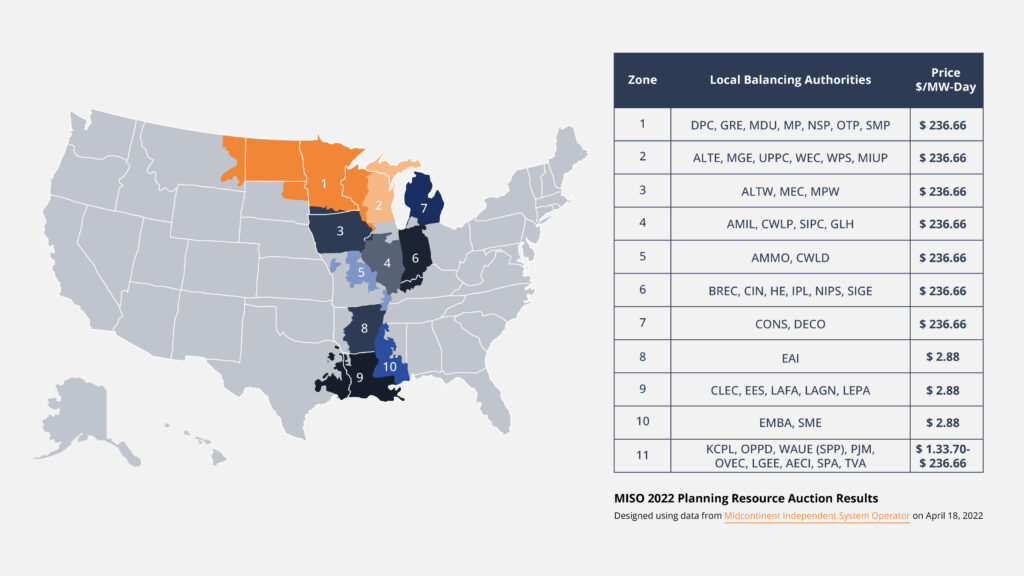In the Midwest, Facilities See High Capacity Charges and Outage Risks

In the MISO region, facilities are seeing high capacity charges and the risk of brownouts. Microgrids offer a solution.
We are in the middle of a historic transition to cleaner energy — but it’s not a smooth road. For many of the states within the Midcontinent Independent System Operator (MISO), the trend toward replacing dispatchable assets with renewable generation has created the potential for power shortfalls during summer’s peak demand.
MISO forecasts that demand will reach 124 GW this summer — which is expected to be in the top-ten hottest summers on record. Unfortunately, the region only has 119 GW of readily available power. As a result, facilities in 11 MISO states — Illinois, Indiana, Iowa, Kentucky, Michigan, Minnesota, Missouri, Montana, North Dakota, South Dakota, and Wisconsin — are facing high capacity charges and the potential for brownouts.
With the impact of the energy transition already hitting utility customers, large consumers of power should consider microgrids for on-site, affordable, resilient power for their facilities.
Rising Prices Reflect Power Shortfalls and Outage Risks
Following years of relatively stable pricing, MISO capacity charges have spiked. Capacity charges are the fees that ratepayers are billed to ensure power is available during peak demand hours. Many facilities rely on large amounts of energy around the clock to ensure they can maintain operations, but that ability now comes at a higher price than ever. These charges are in addition to bills for actual energy use, which are also high, and may not decrease, with wholesale forward power prices recently reaching $121.76/MWh compared with $51.82/MWh in January 2022.
In April, MISO’s 2022-2023 Planning Resource Auction revealed capacity shortfalls for Zones 1-7, which includes parts of 11 states in the North/Central Regions. Pricing cleared at $236.66/MW-day, compared with just $2.88/MW-day in Zones 8-10, and a significant jump from past pricing closer to just $5/MW-day. This capacity pricing reflected an “increased load forecast, less capacity entering the auction as result of retirement, and the decreased accredited capacity of new resources.”
Essentially, this rise in pricing reflects current risks. The North American Electric Reliability Corp (NERC) released a 2022 Summer Reliability Assessment that confirmed the Midwest may see energy emergencies as temperatures rise. As it stands, the North and Central regions of MISO are “at increased risk of temporary, controlled outages to preserve the integrity of the bulk electric system,” according to the executive director of market operations at MISO.
However, the spike in charges does not sit well with large power users who are required to pay these fees. MISO industrial customers recently filed a complaint with the Federal Energy Regulatory Commission, seeking to avoid capacity charges when they voluntarily reduce their load.
MISO Case Study: Michigan
Michigan exemplifies the issues some states are facing this summer. As stated by the executive director of the Citizens Utility Board of Michigan, “Michigan customers pay some of the highest rates for some of the most unreliable electric service in the country.”
The state may be able to avoid some power outages. In Michigan, residential and industrial customers can opt-in to lower rates if they voluntarily reduce power usage. This is usually enough to prevent outages during peak demand times. And yet, if MISO requires load shedding, areas with sufficient generation would nonetheless see rolling blackouts. Unfortunately, some industrial customers cannot afford this level of load shedding.
Storms are another issue. In August 2021, areas of Michigan experienced over a week of outages due to severe storms, disrupting lives and workplaces. The CEO of DTE Energy explained that climate change-fueled storms have been a challenge and that improving power delivery is a priority. And yet, DTE Energy is rapidly retiring coal-fired power plants, making strides toward carbon-neutral but providing fewer options for dispatchable energy.
Microgrids Are a Solution for the New Normal
Across the country, capacity issues mean facilities are seeing an increased risk of utility outages while receiving higher bills. As the energy transition continues, there will be more ‘gaps’ in power generation that result in price volatility and less reliable power.
Microgrids offer a solution for large power users through on-site power generation. Facilities can reduce their utility bills and avoid extraneous charges regardless of the state of the grid, as they can enter island mode to support the site’s operations even during lengthy outages. In addition, microgrids can cut your emissions so you can play your part in the energy transition, without the risks.
To learn more about the benefits of a Unison Energy microgrid, click here to contact a Unison Energy sales representative.
Energy insights, delivered
Subscribe for more content.

